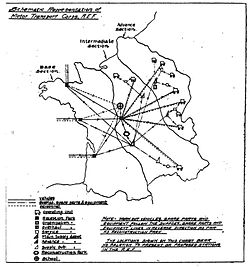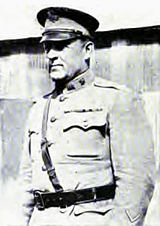- Motor Transport Corps
-
This article is about the World War I American military corps. For the World War II British women's organisation, see Mechanised Transport Corps.
The Motor Transport Corps (M.T.C.) was formed out of the Quartermaster Corps on 15 August 1918, by General Order No. 75. Men needed to staff this new corps were recruited from the skilled tradesmen working for automotive manufacturers in the U.S.
Contents
Organization
The first director of the M.T.C. was Brig. Gen. Meriwether Lewis Walker of Lynchburg, Virginia. Walker was chief engineer of the Pancho Villa Expedition in 1916–17. He later was appointed governor of the Panama Canal Zone. The deputy director was Col. Francis Horton Pope of Kansas. The M.T.C. was headquartered in Tours during the duration of World War I.
Functions
General Order No. 75 spelled out the functions of the Motor Transport Corps as:
- The technical supervision of all motor vehicles.
- The design, production, procurement, reception, storage, maintenance and replacement of all motor vehicles, and accounting for same.
- The design, production, procurement, storage and supply of Transport Corps garages, parks, depots and repair shops.
- The procurement, organization and technical training of Motor Transport Corps personnel.
- The salvage and evacuation of damaged motor vehicles.
- The homogeneous grouping of motor vehicles.
- The operation, in accordance with instruction from the proper commanding officer as to their employment, of groups of motor vehicles of "First Class".
- The preparation of plans for hauling cargo and personnel over military roads, or roads under military control will be under the control of the Motor Transport Corps.
- The procurement, supply, replacement and preliminary training before assignment to combatant organizations, of personnel for operation of motor vehicles of the "Second Class", will be made by the Motor Transport Corps.
Types of motor vehicles
General Order No. 75 also defined a "motor vehicle" as:
- Bicycles
- Motorcycles
- Automobiles
- Trailers and Trucks
Excluded from this definition were:
- Tractors of the caterpillar type, designed primarily for traction purposes
- Tanks
These were to be under the control of the Ordnance Department.
Wartime Operation: 1918–1919
The American Expeditionary Force that deployed to France during World War I was in need of an organization that could log, track and maintain all needed motor transportation. A school and a network of parks were set up to accomplish this.
School
All M.T.C. and some non-M.T.C. personnel were to attend training programs to learn operation and repair of motor vehicles. Some courses offered:
- Convoy driving
- Rules of the road
- Oiling, greasing and cleaning
- Map reading
- Motorcycle operation and repair
- Practical shop work
- Repairs of solid and pneumatic tires
- Oxy-acetylene welding
Parks
Reception Parks
Vehicles were unloaded, uncrated and assembled at these parks, then assigned a registration card and markings. Detailed records were kept on each vehicle's whereabouts and conditions. Vehicles and spare parts collected in these parks awaited assignments to specific army units as requested. With the exception of the highest ranking officers, no officer had his own personal car during the war. A large reception park was located in St. Nazaire.
Service Parks
Designed to make repairs not requiring much time or heavy equipment, these mostly mobile workshops carried a limited stock of spare parts and were mainly assigned to combat zones. Because of their temporary and mobile nature, the service parks were often operating in the open, under canvas, or in any shelter found to be available.
Overhaul Parks
These parks were to occupy permanent or semi-permanent structures for basic vehicle maintenance and repair. They were to be located 30 miles (48 km) behind the fighting zone (40 miles if behind a "thinly held sector"). When the cost of a repair exceeded 30% of the first cost of the vehicle, they were to be sent to a reconstruction park for salvage.
Reconstruction Park
A permanent facility equipped for large scale rebuilding and salvage operations. A temporary park in Nevers was relocated in July 1918 to a permanent facility in Verneuil, Nièvre, 30 miles (48 km) east of Nevers. The M.T.C. Reconstruction Park covered approximately 1,000 acres (4 km2) and consisted of five steel shops averaging 25,000 sq ft (2,300 m2) each and a large warehouse for storage of spare parts. The park was staffed by three units of approximately 1,150 men each (Units 301, 302, and 303). Some labor was also supplied by German prisoners who were housed inside the Park.
Command of the park at Verneuil was assigned to Colonel Harry A. ("Bull") Hegeman, who was awarded the Distinguished Service Medal for his involvement in the operation, in spite of the post-war accusation of mismanagement and waste there. Hegeman was a mechanical engineer from Sparta, Wisconsin.
Post War: 1919–1920
According to the M.T.C. Reconstruction Park newsletter "Let's Go", the park was visited by General John J. Pershing and later, General James Harbord, in April 1919.
The parks were closed after the war and the Motor Transport Corps was dissolved in 1920.
See also
- G-numbers
- M1918 light repair truck
- Liberty truck
External links
- World War I
- U.S. Army Transportation Corps
- U.S. Army Transportation Museum
- The U.S. Army Quartermaster Museum in Fort Lee, Virginia
- Francis Horton Pope—Arlington National Cemetery Website
- United States Army Quartermaster Corps
- http://www.archive.org/details/americasmunitio01deptgoog
References
- Manual of the Motor Transport Corps. United States War Department. 1919.
- Marcosson, Isaac Frederick (1919). S.O.S. America's Miracle in France. New York: John Lane Company.
- War Expenditures—Hearings before Subcommittee No. 3 of the Select Committee on Expenditures in the War Department.. Serial 4—Parts 27 and 38. Government Printing Office. 1920. http://www.loc.gov/library/libarch-digital.html.
- Geller, Lawrence D (June 1989). The American Field Service Archives of World War I, 1914–1917. Westport, CT: Greenwood Publishing Group. ISBN 9780313267949.
Categories:- Military logistics of the United States
- Branches of the United States Army
- Military units and formations established in 1918
- Quartermasters
- Military logistics
- Military units and formations of the United States in World War I
- Military transport
- 1918 establishments in the United States
Wikimedia Foundation. 2010.



